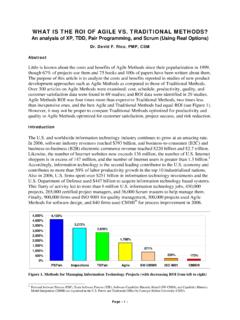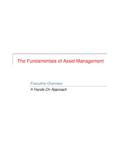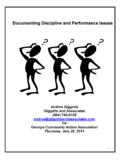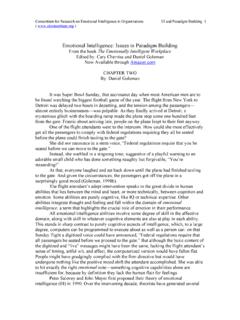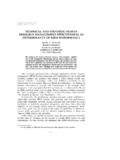Transcription of The Business Value of Using Agile Project …
1 The Business Value of Using Agile Project management for New Products and Services by Dr. David F. Rico, PMP, ACP, CSM. What is the Business Value of Agile Project management for creating new products and services? In other words, What are the costs, benefits, or what is the ROI of Agile Project management ? . Has anyone ever measured the benefits of Agile Project management ? If so, what are the results? Furthermore, is there a measurable difference between Agile and traditional Project management ? Agile Project management crept into practice about a decade ago and quickly became the predominant paradigm for managing IT projects. However, Agile Project management continues to spread throughout the world-wide marketplace, including the public sector ( , government projects). As such, these questions and many more are being asked in increasing frequency. Agile Project management is a blend of older traditional ideas and newer discoveries for creating innovative products and services.
2 It is lightweight, flexible, collaborative, and adaptable to frequent change, yet highly disciplined. This gives us the structure of the rational model from the last century along with the market and technological sensitivity to manage 21st century projects. Agile Project management is not just a fancy name for an old idea. It is a better way for managing high-risk, time-sensitive research and development oriented projects. Its lightweight structure leads to better productivity and efficient decision-making, while exceeding the quality characteristics of older paradigms. These alone result in lower costs and faster time-to-market. However, because frequent customer interaction and early concept testing are used to elicit tacit needs, it results in outcomes that are sensitive to the market. This boosts customer satisfaction, which improves customer trust, retention, loyalty, and repeat Business . These additional benefits translate into economic benefits such as improved sales, revenues, and overall profitability.
3 Agile Project management is squarely focused on capturing and implementing only the highest priority market and customer needs that result in the greatest return on investment for them. This provides customers with the biggest bang for the buck, while reducing the operational workload on a Project 's team members. This improves morale, sustainability, and Business performance. An early study of Agile Project management showed 10% to 20% improvements in revenues, quality, and cycle time, and 54% reductions in costs. Another early study showed 50% to 60%. reductions in time to market and costs, along with 10 times higher development flexibility. These studies were often done at the organizational level, which somewhat diluted the effects. Year Author Org. Result 20% improvement in communication, quality, and cycle time 1998 Weill Harvard 13% increase in strategic alignment, sales, and revenues 54% reduction in product and service development costs 50% reduction in development effort 1998 Thomke Harvard 55% improvement in time to market 925% improvement in number of changes allowed 48% productivity increase over traditional methods 1998 MacCormack Harvard 38% higher quality associated with more design effort 50% higher quality associated with iterative development 38% reduction in time to produce products and services 1999 Fichman Boston 50% time to market improvement 50% more capabilities delivered to customers As shown below, newer studies of Agile Project management squarely focused on the Project as a unit of measure rather than the organization.
4 In most cases, productivity, cost, and, quality gains were significantly higher than those of earlier studies ( , greater than 50%). VersionOne conducts annual surveys with little variation in results in spite of increasing sample sizes. Sample Improvements Year Author Organization Size Productivity Cost Savings Quality 2003 Johnson Shine 131 93% 49% 88%. 2006 Barnett Agile Journal 400 45% 23% 43%. 2007 Begel Microsoft 492 14% 16% 32%. 2007 Rico UMUC 250 81% 75% 80%. 2008 Ambler AmbySoft 642 82% 72% 72%. 2008 Wolf IT Agile 207 78% 72% 74%. 2008 Hanscom VersionOne 3,061 74% 38% 68%. Average 67% 49% 65%. In 2008, the University of Maryland developed a database with over 153 data points on the costs and benefits of Agile Project management from 72 The benefits of Agile vs. traditional projects were higher in every metric. Return on investment was nearly six times higher for Agile Project management . The studies of Agile Project management were often of better quality.
5 Metric Agile Traditional Difference Cost Reduction 29% 20% 9%. Schedule Reduction 70% 37% 33%. Productivity Improvement 117% 62% 55%. Quality Improvement 74% 50% 24%. Customer Satisfaction Imp. 70% 14% 56%. Return on Investment 2,811% 470% 2,341%. In 2009, the University of Maryland conducted a detailed return on investment study of Agile Project Cost and benefit metrics, models, and measures were developed based on 52 data points from 32 studies. These models were used to estimate the ROI of Agile Project management , which was at least 10 times greater than traditional Project management . Method Costs Benefits B/CR ROI NPV ROA. Extreme Prog. $127,125 $4,382,872 34:1 3,348% $3,667,983 $4,283,867. Agile Methods $217,712 $4,292,285 20:1 1,872% $3,498,958 $4,125,209. Test Driven Dev. $249,653 $4,260,344 17:1 1,607% $3,439,359 $4,073,167. Pair Prog. $265,437 $4,244,560 16:1 1,499% $3,409,908 $4,048,404. Scrum $505,259 $4,004,738 8:1 693% $2,962,424 $3,715,411.
6 Traditional $1,108,233 $3,023,064 3:1 173% $1,509,424 $2,633,052. Note: B/CR Benefit/Cost Ratio, ROI Return on Investment, NPV Net Present Value , ROA Real Options Analysis The University of Maryland study also found that Agile projects were 20 times more productive, had five times better cost and quality, and had a 7 times earlier breakeven point. Furthermore, Agile projects had an 11 times greater ROI, 11 times higher NPV, and a 13 times higher ROA. when expressed as a percentage. The best projects have even greater quality, which doubles ROI. A similar study of the costs and benefits of Agile Project management was conducted by a market-leading Data was gathered from 23 Agile projects and compared to a database of 7,500 traditional ones. The vendor reported that Agile Project management lowered costs by 61%, reduced schedules by 24%, improved quality by 93%, and improved productivity by 39%. The Business Value of Agile Project management is an order of magnitude improvement over traditional methods from the 20th century.
7 Another way to express this is that Agile Project management is at least 10 times better or a 10X solution as claimed by other 20th century total quality management paradigms. Done well, Agile Project management yields impressive benefits. Its benefits come from many factors that are too numerous to mention here. The primary drivers are increased productivity and quality. Productivity comes from its streamlined nature and quality from its uncompromising discipline. However, its real power comes from its adaptability to change, collaborative nature, and focus on bottom line Business results for the marketplace. Global competition is at an all-time high, technology is advancing at an unrelenting pace, and organizations must produce more with fewer resources. Executives are turning to Agile Project management as a key solution to thwart the 21st century management crisis. Over 80% of global firms apply Agile Project management and large public sector projects are joining in droves.
8 Although our knowledge of Project management has never been greater, it continues to evolve rather quickly. It is not the last word, but is merely another stepping stone in our journey towards understanding how to manage 21st century projects. While its lessons should never be forgotten, it is certain to be refined with even greater principles, practices, and tools in the very near future. 1. Rico, D. F. (2008). What is the ROI of Agile vs. traditional methods? An analysis of extreme programming, test- driven development, pair programming, and scrum ( Using real options). TickIT International, 10(4), 9-18. 2. Rico, D. F., Sayani, H. H., & Sone, S. (2009). The Business Value of Agile software methods: Maximizing ROI. with just-in-time processes and documentation. Ft. Lauderdale, FL: J. Ross Publishing. 3. Mah, M. (2008). Measuring Agile in the enterprise: Proceedings of the Agile 2008 Conference, Toronto, Canada. Dr. Rico has been a leader in support of major gov't agencies for 25 years.
9 He's led many Cloud, Lean, Agile , SOA, Web Services, Six Sigma, FOSS, ISO 9001, CMMI, and SW-CMM projects. He specializes in IT investment analysis, portfolio valuation, and organizational change. He's been an international keynote speaker, presented at leading conferences, written six textbooks, and published numerous articles. He's also a frequent PMI, APLN, INCOSE, SPIN, and conference speaker ( ).

